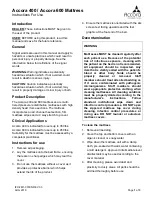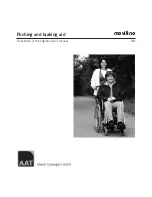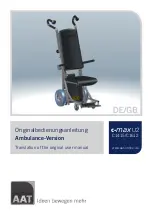
17
© Ferno-Washington, Inc 234-3298-03 February 2013
59T EZ
Glide®
Using the Chair
6.5 Transporting a Patient
Down stairs
GEnEral GUiDElinEs
●
Using the chair to move down stairs requires a
minimum of two trained operators working together.
Use additional help as needed to control the chair (see
Using Additional Help
, page 21).
●
Ferno recommends that the two operators face each
other when transporting a patient on stairs and that a
third trained person “spot” for the foot-end operator.
In some cases, the foot-end operator may be able to
descend the stairs facing forward, with his back to the
patient. Follow your local protocols for using chairs.
●
Remove any water, ice, snow, or debris from the stairs
before using the chair on them.
●
Remove any water, ice, snow, or debris from the track
system and belts before using the chair on stairs.
●
Verify that the track system is locked in the open
position before using the chair on stairs.
●
If the operators tire or need to attend the patient while
on stairs, see
Pausing On the Stairs,
page 20.
GliDinG ThE Chair DOWn sTairs
1.
head-end Operator:
Roll the chair near the stairs and
engage the wheel locks.
2.
head-end Operator:
Open the track system (See
Track System,
page 12). Verify that it has locked.
3.
Both Operators:
Raise the lift bar and/or extend the
foot-end lift handles to the desired positions and verify
that all handles are locked (Figure 20).
4.
Spotter:
Stand below the foot-end operator with a
hand on the operator’s back to help steady and guide
him/her throughout the descent (Figure 20).
5.
head-end Operator:
Disengage the wheel locks.
WarninG
Using the chair with the track system unlocked can
cause injury. Verify that the track system is locked
before transporting the patient.
The Landing Zone
Ferno recommends you visualize a “landing
zone” of at the top or bottom of the stairway.
The landing zone should provide enough
clear, safe space for the chair to be set on
all four wheels, away from the edge of the
stairway.
Figure 20 - Preparing to Descend
Spotter
















































